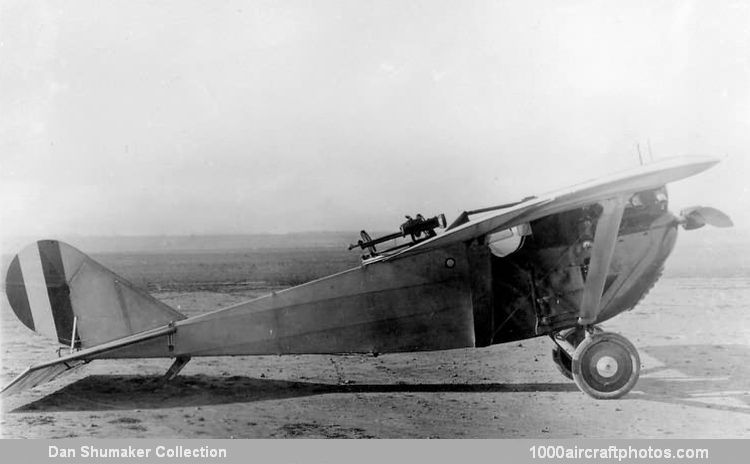11/30/2013. Remarks by Johan Visschedijk: "The Loening monoplanes were a daring innovation in their day, since the field of military aviation in 1918 was dominated almost entirely by biplane-minded pilots, engineers and procurement personnel. Grover C. Loening, who had acquired an aeronautical engineering degree from Columbia University in 1911 by virtually inventing the course, was able to see the inherent speed and structural simplicity advantages of the monoplane and had the tenacity to fight for his beliefs against adamant opposition.
Loening got his chance in 1918, by which time he was a thoroughly experienced engineer, having worked for the Wright Brothers, been chief engineer of the Army Flying School in San Diego, California, and then chief engineer of the Sturtevant Aeroplane Co. After forming Loening Aeronautical Engineering Company at New York, New York, in the spring of 1918, Loening was asked by the USAAS to design a two-seat fighter that would out-perform the famous British Bristol Fighter. The result was the strut-braced high-wing monoplane M-8, powered by a 300 hp engine.
In addition to being a monoplane in a biplane's world, the M-8 had a number of advanced features. One was the radiator installation, which was mounted in a tunnel beneath the engine instead of surrounding the propeller shaft or being a separate bolted-on item outside the fuselage lines, as was customary. This feature was widely adopted by other high-performance military aircraft in the post-war years.
The parallel lift-struts connecting the wing to the lower longeron were fitted with wide fairings of airfoil section that were expected to contribute lift. This feature was to become a trademark of the famous Bellanca monoplanes of 1925-1940. With the upper longerons at the level of the wing, the rear gunner had a terrific field of fire for his twin 0.30 in (7.62 mm) Lewis guns. The pilot, of course, had the same unobstructed view above for fighting and could also see under the wing through windows below the longerons.
Initial procurement was expedited by having the Wright-Martin Company request the Loening Aeronautical Engineering Corporation to build two M-8 prototypes (USAAS serials 40121, 40122) as test beds for the Wright H-3 engine, an Americanized version of the 300 hp French Hispano-Suiza.
First flown in August 1918, the M-8 met all performance expectations, and in spite of certain structural and aerodynamic problems, a contract for 5,000 was placed, but the wholesale cancellations that followed the Armistice kept production models from being built for the USAAS. The first prototype (serial 40121) was tested at McCook Field under the Project Number "P-59"; it was surveyed on October 20, 1926.
The USN, having taken a low-cost sample of Loening's basic monoplane design with three ultralight Kittens (BuNos. A-442 to A-444) that were designed as ships' planes and were considered for quick disassembly and stowage aboard submarines, took an interest in the full-size fighter design after the war and ordered a single M-8 (BuNo. A-5631).
This was followed by orders for 46 naval production models, ten designated M-8-0 (sometimes written as M-80, BuNos. A-5637 to A-5646) and 36 designated M-8-1 (M-81, BuNos. A-5701 to A-5710 and A-5761 to A-5786) which, although designed as fighters, were used for observation purposes. An additional six were ordered as M-8-1S twin-float seaplanes (BuNos. A-5788 to A-5793), and at least one of these was tested as an amphibian with wheels built into the bottoms of the floats.
Three practically identical models, designated LS for Loening seaplane, were also ordered, but the last two were cancelled. The single LS (BuNo. A-5606) was used to test the unique Richardson Pontoon which was in effect a standard float of somewhat greater than standard width split along the center line. These halves were then moved apart to standard twin-float positions beneath the seaplane. The vertical inside face of each separate float was supposed to improve the water-handling characteristics of the combination, but nothing seems to have come of it and the experiment was dropped.
The USN attempted to capitalize on the loudly proclaimed speed advantages of the monoplane by fitting one M-8-1 (BuNo. A-5791) with a special set of small wings for its entry in the 1920 Pulitzer race. It had a reduced span and chord, and the wide lifting-struts were replaced by thin streamlined steel tubes. The racer, flown by Lieutenant B.G. Bradley of the USMC, developed a water leak early in the race which forced it out in the last lap after achieving a speed of 160 mph (257 kmh) around the closed course.
It was irony for Loening that after this misfortune the USN pinned its racing hopes on biplanes and even kept a pair of triplanes in service for such purposes through the 1923 season. He was able to sell a handful of monoplane fighters and racers to the USAAS in the years 1920-1922, but had to fall back on the traditional biplane in order to win significant orders and did not introduce another monoplane for over a decade."
